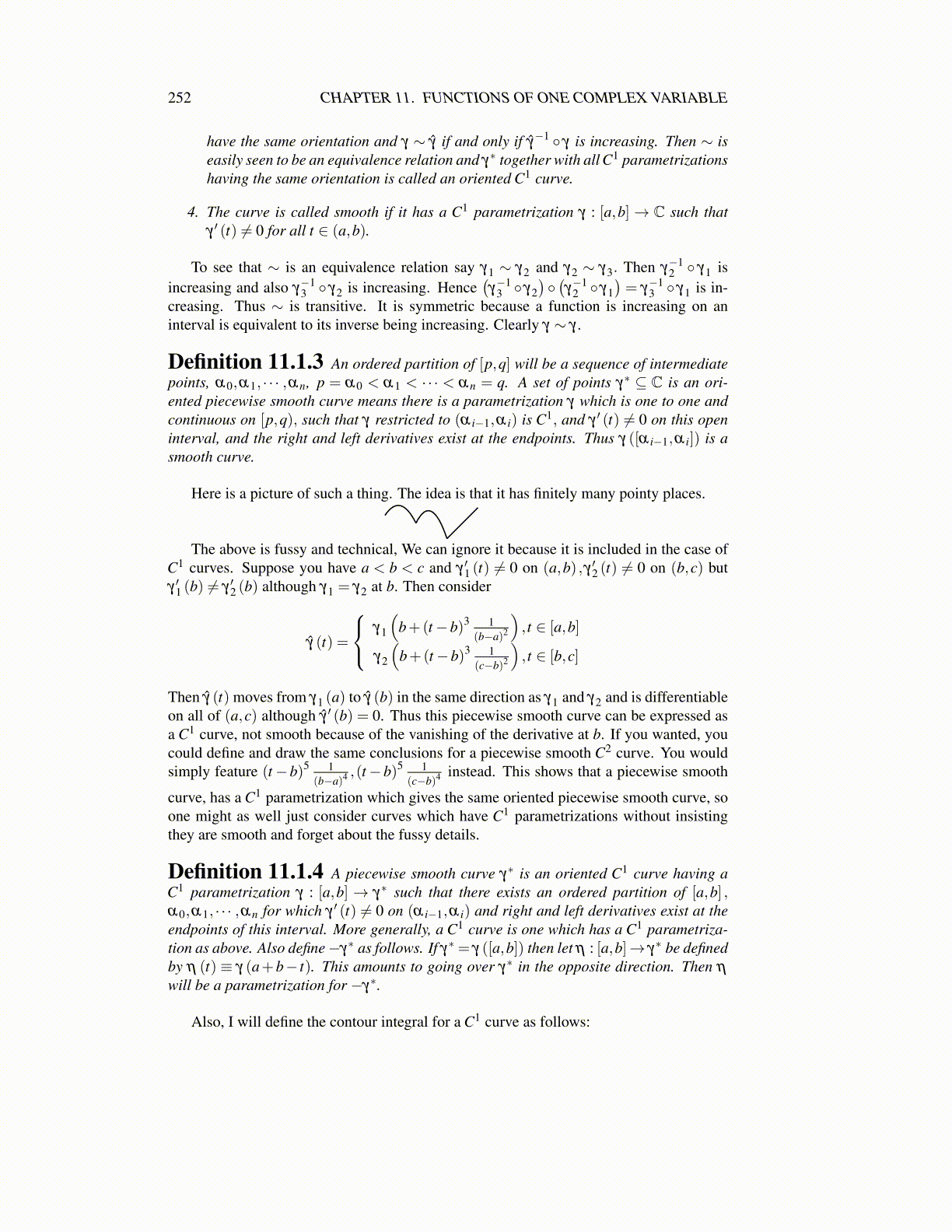
252 CHAPTER 11. FUNCTIONS OF ONE COMPLEX VARIABLE
Now if η is the above parametrization corresponding to−γ∗,η ′ (t) =−γ ′ (a+b− t) . Thusletting s = a+b− t∫ b
af (η (t))η
′ (t)dt = −∫ b
af (γ (a+b− t))γ
′ (a+b− t)dt
=∫ a
bf (γ (s))γ
′ (s)dt =−∫ b
af (γ (t))γ
′ (t)dt
As to the estimate.∣∣∣∫ b
a f (γ (t))γ ′ (t)dt∣∣∣ = ω
∫ ba f (γ (t))γ ′ (t)dt for a suitable complex
number, |ω|= 1 and the last expression must be∫ b
a Re(ω f (γ (t))γ ′ (t))dt ≤∫ b
a M |γ ′ (t)|=ML.
Why is the length well defined? Say γ, γ̂ are two parametrizations yielding the sameorientation γ : [a,b]→ γ∗ and γ̂ : [c,d]→ γ∗. Then let s = γ̂
−1 ◦ γ (t) then by the samechange of variables result,∫ d
c
∣∣γ̂ ′ (s)∣∣ds =∫ b
a
∣∣∣γ̂ (γ̂−1 ◦ γ (t)
)∣∣∣(γ̂−1 ◦ γ
)′(t)dt
=∫ b
a
∣∣∣γ̂ (γ̂−1 ◦ γ (t)
)∣∣∣(γ̂−1 ◦ γ
)′(t)dt
=∫ b
a
∣∣∣∣γ̂(γ̂−1 ◦ γ (t)
(γ̂−1 ◦ γ
)′(t))∣∣∣∣dt =
∫ b
a
∣∣γ ′ (t)∣∣dt
The last claim follows right away from the estimate. If fn→ f uniformly on γ∗, then∣∣∣∣∫γ∗
fn (z)dz−∫
γ∗f (z)dz
∣∣∣∣≤ εL
whenever n is large enough that max{| fn (z)− f (z)| : z ∈ γ∗}< ε .I will sometimes write
∫γ
f (z)dz instead of∫
γ∗ f (z)dz where it is understood that γ
symbolizes any of the similar parametrizations of γ∗ for one of the two orientations.
11.2 Cauchy Goursat, Cauchy Integral TheoremIn calculus, every continuous function has an antiderivative thanks to the fundamental the-orem of calculus. However, the situation is not at all the same for functions of a complexvariable. This is why we have the following definition using a different word.
Definition 11.2.1 A function F with F ′ = f is called a primitive of f .
So what if a function has a primitive? It turns out that it becomes very easy to computethe contour integrals.
Theorem 11.2.2 Suppose γ∗ is an oriented C1 curve Suppose f : γ∗ → C is con-tinuous and has a primitive F. Thus F ′ (z) = f (z) for some Ω ⊇ γ∗. Then
∫γ
f (z)dz =F (γ (b))−F (γ (a)) .
Proof: By definition and the chain rule for derivatives,∫γ
f (z)dz =∫ b
af (γ (t))γ
′ (t)dt =∫ b
a
ddt
(F (γ (t)))dt = F (γ (b))−F (γ (a))